
The House of Este is a European dynasty of North Italian origin whose members ruled parts of Italy and Germany for many centuries.
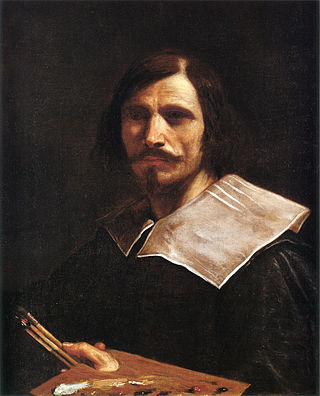
Giovanni Francesco Barbieri, better known as Guercino, or il Guercino[ɡwerˈtʃiːno], was an Italian Baroque painter and draftsman from Cento in the Emilia region, who was active in Rome and Bologna. The vigorous naturalism of his early manner contrasts with the classical equilibrium of his later works. His many drawings are noted for their luminosity and lively style.
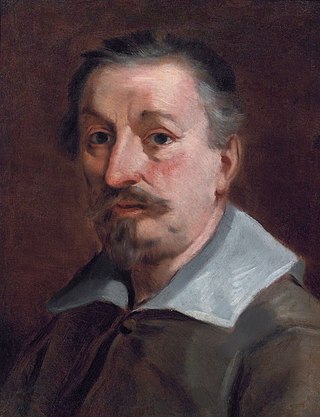
Francesco Albani or Albano was an Italian Baroque painter who was active in Bologna (1591–1600), Rome (1600–1609), Bologna (1609), Viterbo (1609–1610), Bologna (1610), Rome (1610–1617), Bologna (1618–1660), Mantova (1621–1622), Roma (1623–1625) and Florence (1633).

Francesco Francia, whose real name was Francesco Raibolini was an Italian painter, goldsmith, and medallist from Bologna, who was also director of the city mint.

Justus Sustermans, Joost Sustermans or Suttermans, his given name Italianised to Giusto, was a Flemish painter and draughtsman who is mainly known for his portraits. He also painted history and genre paintings, still lifes and animals.

Marcantonio Franceschini was an Italian painter of the Baroque period, active mostly in his native Bologna. He was the father and teacher of Giacomo Franceschini.

Sebastiano Ricci was an Italian painter of the late Baroque school of Venice. About the same age as Piazzetta, and an elder contemporary of Tiepolo, he represents a late version of the vigorous and luminous Cortonesque style of grand manner fresco painting.
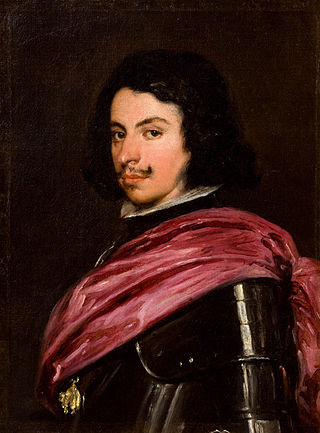
Francesco I d'Este was Duke of Modena and Reggio from 1629 until his death. The eldest son of Alfonso III d'Este, he became reigning duke after his father's abdication.

Isabella of Savoy was a daughter of Charles Emmanuel I, Duke of Savoy, and Catherine Michelle of Spain. Her maternal grandparents were Philip II of Spain and Elisabeth of Valois, her paternal grandparents were Emmanuel Philibert, Duke of Savoy and Margaret of France, Duchess of Berry. She was the Hereditary Princess of Modena, dying before her husband succeeded to the Duchy of Modena in 1628.

Domenico Robusti, also known as Domenico Tintoretto, was an Italian painter from Venice. He grew up under the tutelage of his father, the renowned painter Jacopo Tintoretto.

The Galleria Estense is an art gallery in the heart of Modena, centred around the collection of the d’Este family: rulers of Modena, Ferrara and Reggio from 1289 to 1796. Located on the top floor of the Palazzo dei Musei, on the St. Augustine square, the museum showcases a vast array of works ranging from fresco and oil painting to marble, polychrome and terracotta sculpture; musical instruments; numismatics; curios and decorative antiques.
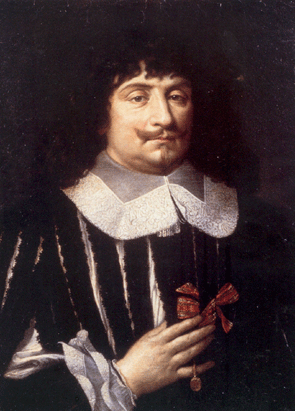
Fulvio Testi was an Italian diplomat and poet who is recognised as one of the main exponents of 17th-century Italian Baroque literature. He worked in the service of the d'Este dukes in Modena, for whom he held high office, such as the governorship of Garfagnana. His poems tackle civic themes in solemn tones, showing Testi's lasting anti-Spanish and, consequently, pro-Savoia political passions. Accused of treason for having tried to set up diplomatic relations with the French court, he was imprisoned and died in jail soon after. One later literary critic wrote:
If he'd been born in a less barbarous age, and had had more time than he did to cultivate his talent, he would doubtless have been our Horace, and perhaps been hotter and more vehement and more sublime than the Latin man

Madonna and Child with Saint George is an oil on panel painting by Correggio dating to around 1530 and now in the Gemäldegalerie in Dresden.
The Studiolo of Isabella d'Este was a special private study, first in castello di San Giorgio, later the Studiolo was moved to the Corte Vecchi apartments in the Ducal Palace in Mantua, designed by, and with a collection of art specially commissioned by Isabella d'Este.
The Gallerie Estensi is a network of three museums and a library, bringing together the collective fruits of artistic production from Ferrara, Modena and Sassuolo in the Emilia-Romagna region of Northern Italy. The galleries aim to preserve the historic heritage left by the influential House of Este, with a focus on relating their noble past to the local communities at each site.
Borso d'Este was an Italian general, a member of the ducal House of Este. He was the son of Cesare d'Este, Duke of Modena and Virginia de' Medici.

Annunciation is a 1646 oil on canvas painting by Guercino, now in the collegiate church of Santa Maria Maggiore in Pieve di Cento, a few kilometres from the painter's birthplace of Cento. The artist used the same colours for Mary's clothes in his 1656 Immaculate Conception, along with the face of God.

The Dying Cleopatra or The Death of Cleopatra is a c. 1648 oil on canvas painting by Guercino, now in the Palazzo Rosso in Genoa.

The Suicide of Cato is a 1641 oil on canvas painting, now in the Palazzo Rosso in Genoa.
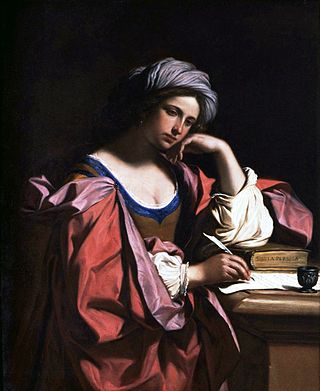
The Persian Sibyl is a 1647 oil on canvas painting of the Persian Sibyl by Guercino, now in the Musei Capitolini in Rome.
















